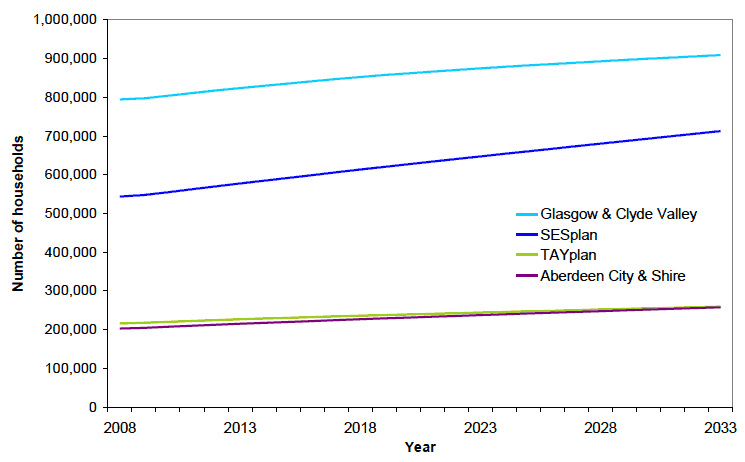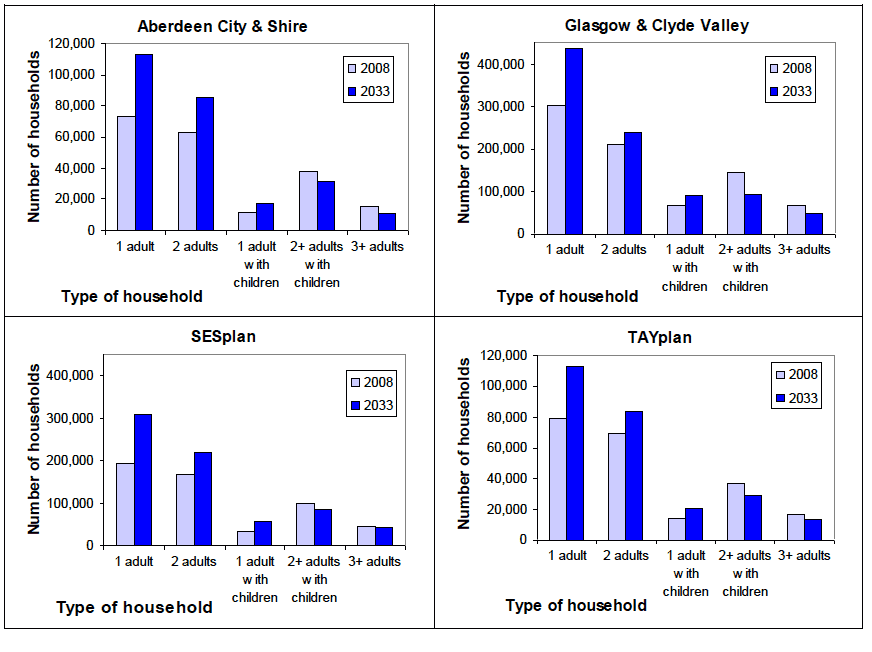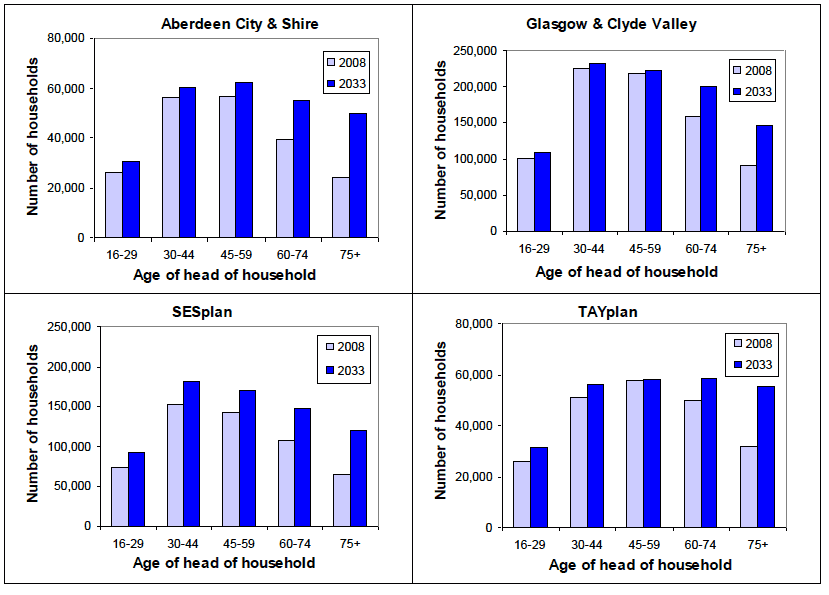
The key points, relating to the Strategic Development Plan (SDP) areas, are:
Household Type
Age Group
The following table shows a summary of the percentage changes in population and the number of households, for SDP areas and the whole of Scotland, over the projection period 2008-2033,
Table D: Percentage change in population and number of households, for SDP areas and the whole of Scotland, 2008 to 2033
| Aberdeen City & Shire |
Glasgow & Clyde Valley | SESPlan | TAYPlan | Scotland | |
|---|---|---|---|---|---|
| Population | 14% | 0% | 17% | 8% | 7% |
| Children (0-15) | 4% | -9% | 9% | 2% | -2% |
| Working Age1 | 7% | -4% | 13% | 2% | 2% |
| Pensionable Age2 | 48% | 23% | 38% | 28% | 31% |
| Households | 27% | 14% | 31% | 20% | 21% |
| Headed by under 60 year old | 10% | 3% | 20% | 8% | 7% |
| Headed by over 60 year old | 65% | 39% | 56% | 40% | 47% |
| Headed by over 85 year old | 183% | 139% | 166% | 164% | 168% |
| Household types | |||||
| 1 adult | 53% | 44% | 58% | 44% | 49% |
| 1 adult, 1+ children | 44% | 36% | 64% | 44% | 46% |
| 2 adults | 35% | 14% | 31% | 20% | 23% |
| 2+ adults, 1+ children | -20% | -35% | -15% | -23% | -27% |
| 3+ adults | -30% | -32% | -8% | -18% | -27% |
| Average household size 2008 | 2.16 | 2.17 | 2.19 | 2.13 | 2.18 |
| Average household size 2033 | 1.93 | 1.89 | 1.95 | 1.91 | 1.93 |
1 Working age is 16-59 for women and 16-64 for men
until 2010. Between 2010 and 2020 working age becomes 16-64 for
women. Between 2024 and 2026, working age for both men and women
becomes 16-65 and changes again, in two further steps, to 16-67 by
2046.
2 Pensionable age is 65 for men and 60 for women
until 2010. Between 2010 and 2020, the pensionable age for women
increases to 65. Between 2024 and 2026, the pensionable age for
both men and women increases to 66 and changes again, in two
further steps, to 68 by 2046.
3.2.1 Overall number of households
The projected numbers of households in SDP areas from 2008 to 2033 are shown in Tables 5a to 5d and illustrated in Figure 4.
Figure 4: Projected number of households in SDP areas, 2008-2033

The number of households in Scotland is projected to increase from 2.3 million to 2.8 million between 2008 and 2033, an increase of 21 per cent. All SDP areas show projected increases during this period:
3.2.2 Types of household (Tables 5a to 5d)
Detailed information on types of household can be found in Tables 5a to 5d and is illustrated in Figure 5. In all SDP areas, there are large projected increases in the numbers of adults living alone. The number of households containing just two adults without children and the number of households containing one adult with children are projected to increase as well.
In contrast, the number of larger households is projected to fall. The number of households containing two or more adults with children and the number of households containing three or more adults are both projected to decrease.
Figure 5: Projected number of households in SDP areas by household type, 2008 and 2033

Please note that scales on the y-axis differ between graphs.
3.2.3 Age group of head of household (Tables 6a to 6d)
Figure 6 shows the projected number of households in 2008 and 2033, by age group of head of household. Detailed information for the age group of the head of household can also be seen in Tables 6a to 6d.
The ageing population, with a projected increase in the number of people in the older age groups, and fewer people in the younger age groups, is reflected in the household projections, with the largest increases in households headed by people aged 60 and over. Between 2008 and 2033, the projected percentage increases for households headed by people aged 60 and over range from 39 per cent in Glasgow & Clyde Valley SDP area, to 65 per cent in Aberdeen City & Shire SDP area.
Projected changes in households headed by people aged less than 60 are smaller and vary more across the country. A small increase of three per cent is projected for Glasgow & Clyde Valley SDP area, with the largest increase of 20 per cent projected for SESplan SDP area.
Between 2008 and 2033, there are large projected increases in the number of households headed by someone aged 85 or over in all the SDP areas, ranging from 139 per cent in Glasgow & Clyde Valley SDP area to 183 per cent in Aberdeen City & Shire SDP area.
Figure 6: Projected number of households in SDP areas by age group of head of household, 2008 and 2033

Please note that scales on the y-axis differ between graphs.
3.2.4 Household type by age group of head of household (Tables 7a to 7d and Tables 8a to 8d)
One adult households
In Scotland in 2008, 20 per cent of the population aged 16 or over lived alone, and this is projected to rise to 29 per cent by 2033. This trend is reflected in all SDP areas.
The figures in Tables 8a to 8d show that people in the older age groups are more likely to live alone. In 2008, in most age groups up to their mid to late 50s, men were more likely to live alone than women. From the age of 55-60 onwards, however, women are more likely to live alone, and the percentages increase with age. Projections for 2033 show a similar pattern, but with men more likely to live alone in most age groups up to their mid to late 60s. There are also more people living alone in all age groups.
The percentage of people aged 85 or over who are projected to be living alone in 2033 ranges from 59 per cent in SESplan SDP area to 66 per cent in Aberdeen City & Shire SDP area. In all SDP areas, women in this age group are much more likely to live alone than men.
The gap between the average life expectancy of men and women in Scotland is decreasing. This means that the number of older men is projected to increase more rapidly than the number of older women. This contributes to the projected increase in the number of men living alone and can be seen in Tables 7a to 7d.
Households containing one adult with children
There are projected increases in the number of households of this type in all SDP areas and for nearly all age groups (particularly people aged 45 and over).
Households containing two or more adults without children
The figures in Tables 7a to 7d show that, in all SDP areas, there are large projected increases in the number of households containing two or more adults without children in the older age groups. This is likely to be influenced by the increase in average life expectancy and the narrowing of the gap between the life expectancy of men and women.
Households containing two or more adults with children
There are projected reductions in the number of households containing two or more adults with children for most age groups, with the biggest reductions occurring in the younger age groups. This may reflect an increase in the average age at which women have their first child. Exceptions to this are in the 45-54 age groups in Aberdeen City & Shire, SESplan and TAYplan SDP areas where there are projected increases.